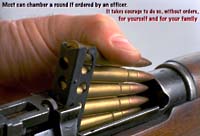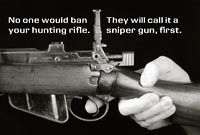

Short Magazine Lee Enfield Mk III & Mk V
![]()
Length - 44.5"
Weight - 8.2lb
Barrel - 25"
Calibre - .303"
Rifling - 5 groove L/Hand
Operation - Bolt Action
Feed - 10 Round Box
Muz. Velocity - 2440 f/s
Sights - 2000 yards
British experience in the South African War of 1899-1902 showed the need for a short rifle for universal use and even before the end of the war a new weapon had been produced and a thousand made for trials. It was also tested against the Mad Mullah in Somaliland, and after some modification emerged as the Short Magazine Lee Enfield Mark II in 1907.
It was an excellent weapon and although slightly less accurate than its predecessor it has certain compensating advantages, notably its easy breech mechanism which allowed a fast rate of manipulation. The British Army had concentrated on rapid fire to the stage where every soldier could fire at least fifteen well aimed shots per minute, and the devastating effects of this were clearly seen in the first few months of WW1 where the gallant German Infantry suffered heavily.
The Mark III was a complex weapon to make and in 1916 various simplifications were introduced, notably the abolition of the magazine cut off and the disappearance of the special long range collective fire-sight which was clearly unnecessary in the age of the machine gun. These changed its designation to the Mark III, perhaps the most famous rifle in British military history.
It remained an excellent weapon with an 18 inch sword bayonet for close quarter work and the ability to project grenades either rodded or from a screw on cup. Soon after the end of the war the British began to consider a new rifle, similar to its predecessor but easier to make by modern mass-production techniques. The first step in this direction resulted in a new Mark V rifle which appeared in small numbers as early as 1923. Apart from an extra barrel band near the muzzle its main difference was that it had an aperture backsight rather than the open U-type of the earlier rifles, experience having shown that this type of sighting was easier to teach, while the increased distance between the backsight and foresight reduced the margin of error and made for more accurate shooting.
In the end, however, it was decided that the conversion of the large existing stocks of rifles would be too expensive and although the development of a new rifle was maintained the British Army continued to rely on its well tried Lee-Enfield until well after the outbreak of war in 1939. The Mark V differed little from its predecessor apart from the fact that it was sighted to 1400 yards.

 Rifle, Short, Magazine Lee Enfield (SMLE) Mark 1 -- Introduced in 1906 |
||||||||||||||||||||||||||||||||||||||||
 Rifle, Short, Magazine Lee Enfield Mark 3 -- 1907, different sights A wartime version for WWI had several mods for ease of manufacture |
||||||||||||||||||||||||||||||||||||||||
 Rifle, Short, Number 4 Mark 1, Short, Magazine Lee Enfield - 1941 Top shown mounting Bayonet Number 9, bottom blow-up mounts "Pig-Sticker" bayonet |
||||||||||||||||||||||||||||||||||||||||
|
||||||||||||||||||||||||||||||||||||||||
|
||||||||||||||||||||||||||||||||||||||||

A BRIEF HISTORY OF THE LEE ENFIELD RIFLE |
||||
| The Lee Enfield rifle, introduced in 1895,
was the main military service rifle of the British Empire
and her Commonwealth countries for over 60 years, over
this period of time it went through various upgrades and
modifications. The most notable alteration being the
adoption of a single size of rifle in 1903 for both the
cavalry and infantry use. This rifle, known as the Short
Magazine Lee Enfield, or SMLE was still Britain's service
rifle in 1939 and was not declared obsolete and
officially replaced until 1941 with another Lee Enfield,
the No4 rifle. The rifle originally introduced in 1895 was designed by James Paris Lee (1831-1904), a Scottish born firearms designer who worked chiefly in the USA and Canada. His design incorporated a "cock-on-closing" bolt with rear locking lugs and a detachable 10 round magazine. This action was combined with Enfield rifling to create the Lee-Enfield. It was the common British practice at the time to designate their service rifles with the name of the action and rifling, hence, the Lee-Metford or Martini-Henry etc. It wasn't until 1926 that the British re-designated their rifles and adopted a number series to identify their ordinance, at this time the SMLE became officially known as the Rifle, No1 MkIII. The rear locking lugs allowed a bolt movement of the same length as the cartridge and the design of the locking surfaces gave a particularly easy movement to the bolt handle. These features combined, made the Lee Enfield the fastest and lightest rifle to manipulate. Aimed fire could be undertaken up to 15 rounds a minute without much fatigue to the trained soldier. Other major benefits to Lee's design was the detachable bolt head which can be threaded off and changed to compensate for varying head space and the 10 round magazine, twice the capacity of other military rifles of the time. Overall the Lee Enfield was an exceptionally good combat rifle, where its robust construction permitted it to operate in the extreme conditions of the battlefield. The Lee Enfield really only had two snags, one was its cartridge. The .303 was a rimmed cartridge and to avoid jamming, the rounds had to be carefully loaded with the rims lying in just the right place. Both, when loading individual rounds into the magazine and also onto the 5 round charger clips. This drawback was placed on the weapon by the British government, who did not want to incur the cost of replacing it's substantive stockpile of .303 ammunition with a modern rimless round. The other was its intensive machining requirements necessary for manufacturing which resulted in slow production, not really a good thing in a wartime setting. These shortcomings were recognized and after World War I a series of trial rifles were produced. Notably the No! MkV, which maintained the same action, body and barrel but incorporated a receiver mounted rear aperture sight. This design led to the No1 MkVI which adopted a number of simplified maching procedures to speed production and the receiver mounted rear aperture sight. It also adopted a stronger receiver, heavier free floating barrel and a slightly shortened fore end (forestock). Finally, in 1939 the Rifle, No4 MkI was introduced and was officially adopted by the British government as the new military service rifle, though serious production didn't begin until 1941. The rifle, like the No1 MkVI, featured a heavy free floating barrel, receiver mounted rear aperture sights, a stronger receiver, a set length/numbered bolt head for easier headspace adjustment and a slightly shortened fore end. What it kept in design from the SMLE was the bolt action design, magazine and unfortunately the caliber (.303 rimmed). The accuracy of the heavier free floated barrel proved well, when selected No4's were fitted with a 4x power sniper scope. This combined with a little stock bedding and some simple tuning, the No4(T) sniper rifle proved to be the best of the war. So good in fact, that after the war some of the No4(T)'s were re-barreled in 7.62mm NATO to continue serving as sniper rifles. The last significant alteration of the Lee Enfield was the No5 MkI or "Jungle Carbine". Late in World War II, jungle warfare brought home the necessity of light equipment and simplicity. Though the No4 rifle was extremely resistant to rust, mud and rough treatment, it was still heavy and long. It was decided that a light, short carbine was needed to suit the demands of jungle fighting, the quick answer was to cut down the No4 and that is exactly what was done. The No5 was light and short all right, and was probably the sexiest looking rifle produced during the war, with it's cut down stock and conical flash hider, complete with a rubber butt pad. The trouble came when it was fired. Being 2 pounds lighter than the No4 but firing the same round, it has a savage kick, coupled with a much louder, sharper noise and muzzle flash. Part of the lightening procedures included shaving metal off of the receiver and from the Knox Form (end of the barrel next to the receiver ring). It was these cuts that are generally thought to have caused a wandering zero problem with this particular rifle, but the debate is still on, both as to whether it has a wandering zero and to it's cause. What I believe the Jungle Carbine needed was a lower powered round as I am sure the designer knew as well. But wartime pressures presumably forced him to ignore ballistic truths and the rest is history. |
||||

Slim Madden near Hill 614
February, 1951
Private H.W. "Slim" Madden thumbs 10 rounds into his Lee Enfield .303 rifle from a stripper clip, while giving covering fire for "B" Company, 3RAR, during their advance on a spur near Hill 614.
RAR's (and Australia's) most highly decorated Korean War Digger, Slim was captured in April, and posthumously awarded the George Cross for his courage as a prisoner.
